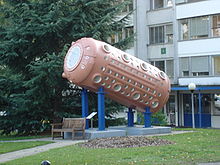Gargamelle


Gargamelle was a
Gargamelle is famous for being the experiment where
Gargamelle can refer to both the bubble chamber detector itself, or the
Background
In a series of separate works in the 1960s
In 1960
A bubble chamber is simply a container filled with a superheated liquid. A charged particle travelling through the chamber will leave an
Conception and construction

The domain of
Due to budgetary crisis, the experiment was not approved in 1966, contrary to what was expected.
The Gargamelle chamber was entirely constructed at
Experimental setup

The chamber
Gargamelle was 4.8 meters long and 2 meters in diameter, and held 12 cubic meters of heavy liquid Freon. To bend the tracks of charged particles, Gargamelle was surrounded by a magnet providing a 2 Tesla field. The coils of the magnet were made of copper cooled down with water, and followed the oblong shape of Gargamelle. In order to maintain the liquid at an adequate temperature several water tubes surrounded the chamber body, to regulate the temperature. The entire installation weighed more than 1000 tons.
When recording an event, the chamber was illuminated and photographed. The illumination system emitted light that was scattered at 90° by the bubbles, and sent to the optics. The light source consisted of 21 point flashes disposed at the ends of the chamber body and over one half of the cylinder.[8] The optics were situated in the opposite half of the cylinder, distributed in two rows parallel to the chamber axis, each rows having four optics. The objective was made by an assembly of lenses with a 90° angular field followed by a divergent lens which extends the field to 110°.
The neutrino beam

Gargamelle was designed for neutrino and antineutrino detection. The source of neutrinos and antineutrinos was a proton beam at an energy of 26 GeV from the PS. The protons were extracted by a magnet and then directed through an appropriate array of quadrupole and dipole magnets, providing the necessary degrees of freedom in position and orientation for adjusting the beam onto target. The target was a cylinder of

After being focused, the pions and kaons were directed through a 70 m long tunnel, allowing them to decay. Pions and kaons that did not decay hit a shielding in the end of the tunnel and were absorbed. When decaying, pions and kaons normally decay in π→μ + ν and K→μ + ν, meaning that the flux of neutrinos would be proportional to the flux of muons. As the muons were not absorbed as hadrons, the flux of charged muons was stopped by an electromagnetic slowing down process in the long shielding. The neutrino flux was measured through the corresponding muon flux by means of six planes of silicium-gold detectors placed at various depths in shielding.[8]
During the years 1971-1976 large improvements factors were obtained in the intensity, first with a new injector for the PS — the Proton Synchrotron Booster — and secondly by the careful study of beam optics.
Results and discoveries

The first main quest of Gargamelle was to search for evidence of hard-scattering of muon-neutrinos and
ν
μ +
e−
→
ν
μ +
e−
or
ν
μ +
e−
→
ν
μ +
e−
. The other line would search for hadronic events — involving a neutrino scattered from a hadron, e.g.
ν
+
p
→
ν
+
p
,
ν
+
n
→
ν
+
p
+
π−
or
p
→
ν
+
n
+
π+
, plus events with many hadrons. The leptonic events have small cross-sections
The first example of a leptonic event was found in December 1972 at Gargamelle by a graduate student from
The Gargamelle collaboration discovered both
Initially the first priority of the Gargamelle had been to measure the neutrino and antineutrino cross-sections and
See also
References
- ^ a b c "Gargamelle". CERN. Retrieved 12 August 2017.
- ^ "The Nobel Prize in Physics 1979". Nobelprize.org. 15 October 1979. Retrieved 28 July 2017.
- .
- ^ "Nobel Prize in Physics 1988: Press Release". Nobelprize.org. Retrieved 16 August 2017.
- ^ a b c Pestre, Dominique (1996). Gargamelle and BEBC. How Europe's Last Two Giant Bubble Chambers were Chosen. Amsterdam: North-Holland. pp. 39–97.
- ^ Haidt, Dieter (2015). "The Discovery of Weak Neutral Currents". In Schopper, Herwig; Di Lella, Luigi (eds.). 60 Years of CERN Experiments and Discoveries. Singapore: World Scientific. pp. 165–185. Retrieved 12 August 2017.
- ^ "Proposal for a Neutrino Experiment in Gargamelle". 16 March 1970. CERN-TCC-70-12. Retrieved 12 August 2017.
{{cite journal}}: Cite journal requires|journal=(help) - ^ a b c Musset, P.; Vialle, J.P. (1978). "Neutrino Physics with Gargamelle". In Jacob, M. (ed.). Gauge Theories and Neutrino Physics. Amsterdam: North-Holland Publishing. pp. 295–425.
- ^ a b Cundy, Donald; Christine, Sutton (25 August 2009). "Gargamelle: the tale of a giant discovery". CERN Courier. CERN. Retrieved 15 August 2017.
- ^ Cundy, Donald (1 July 1974). Neutrino Physics. 17th International Conference on High-energy Physics. London: CERN. pp. 131–148.
- . Retrieved 18 August 2017.
Further reading
External links
- Gargamelle experiment record on INSPIRE-HEP
